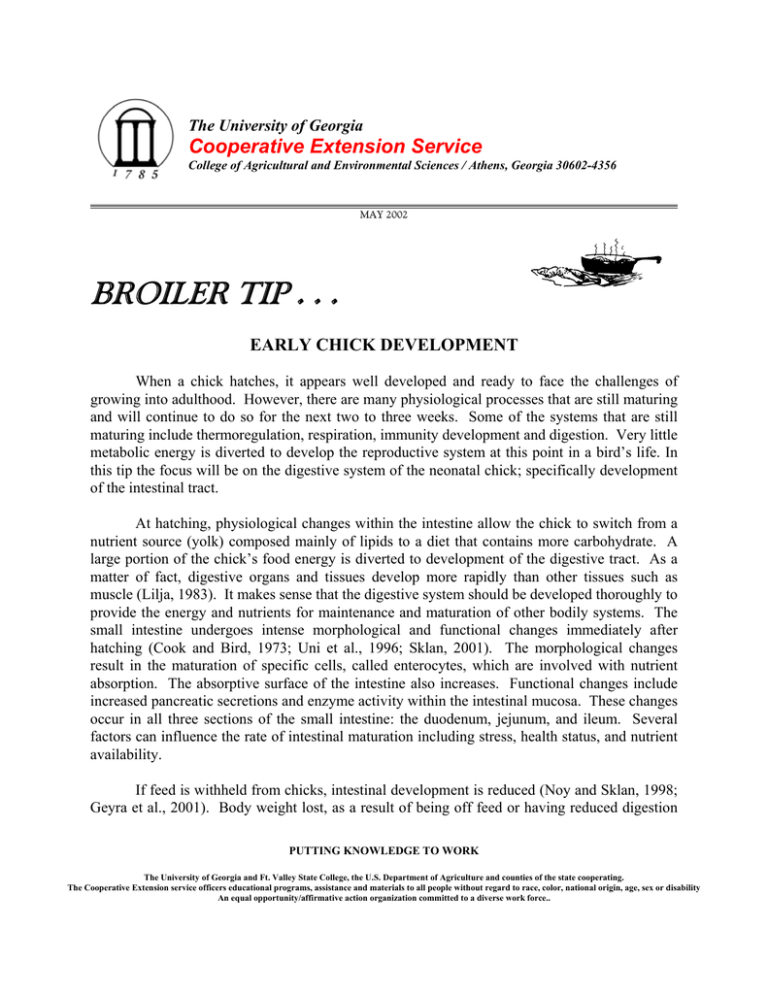BROILER TIP . . . Cooperative Extension Service EARLY CHICK DEVELOPMENT
advertisement

The University of Georgia Cooperative Extension Service College of Agricultural and Environmental Sciences / Athens, Georgia 30602-4356 MAY 2002 BROILER TIP . . . EARLY CHICK DEVELOPMENT When a chick hatches, it appears well developed and ready to face the challenges of growing into adulthood. However, there are many physiological processes that are still maturing and will continue to do so for the next two to three weeks. Some of the systems that are still maturing include thermoregulation, respiration, immunity development and digestion. Very little metabolic energy is diverted to develop the reproductive system at this point in a bird’s life. In this tip the focus will be on the digestive system of the neonatal chick; specifically development of the intestinal tract. At hatching, physiological changes within the intestine allow the chick to switch from a nutrient source (yolk) composed mainly of lipids to a diet that contains more carbohydrate. A large portion of the chick’s food energy is diverted to development of the digestive tract. As a matter of fact, digestive organs and tissues develop more rapidly than other tissues such as muscle (Lilja, 1983). It makes sense that the digestive system should be developed thoroughly to provide the energy and nutrients for maintenance and maturation of other bodily systems. The small intestine undergoes intense morphological and functional changes immediately after hatching (Cook and Bird, 1973; Uni et al., 1996; Sklan, 2001). The morphological changes result in the maturation of specific cells, called enterocytes, which are involved with nutrient absorption. The absorptive surface of the intestine also increases. Functional changes include increased pancreatic secretions and enzyme activity within the intestinal mucosa. These changes occur in all three sections of the small intestine: the duodenum, jejunum, and ileum. Several factors can influence the rate of intestinal maturation including stress, health status, and nutrient availability. If feed is withheld from chicks, intestinal development is reduced (Noy and Sklan, 1998; Geyra et al., 2001). Body weight lost, as a result of being off feed or having reduced digestion PUTTING KNOWLEDGE TO WORK The University of Georgia and Ft. Valley State College, the U.S. Department of Agriculture and counties of the state cooperating. The Cooperative Extension service officers educational programs, assistance and materials to all people without regard to race, color, national origin, age, sex or disability An equal opportunity/affirmative action organization committed to a diverse work force.. and absorption due to intestinal immaturity is not easily recovered. Feed is a significant expense in growing broilers and efforts are constantly being made to improve the feed to gain ratio. However, some practices to increase feed conversion may be inadvertently resulting in delayed maturation of the intestine. Every effort should be made during the first 72 hours to ensure that the chick finds feed and water and begins eating and drinking. Current management practices place birds on constant light for the first two or three days. The practice of placing feeder lids around the brooder is another method that has been used to promote early feed consumption and to keep chicks warm and comfortable. Feeder lids placed between feed pans increase feeder space and enhance the probability that each chick will find feed and begin eating. Care should be taken to ensure that pans have feed but are not overfilled as this can lead to increased feed wastage and hurt feed performance. The provision of proper environment (i.e. temperature, air quality, light, water and feed) minimizes stress on the chick and allows it to search out feed and water. This promotes proper intestinal development that will in turn result in healthy chicks that thrive. REFERENCES Cook, R. H. and F. H. Bird, 1973. Duodenal villus area and epithelial cellular migration in conventional and germ-free chicks. Poultry Sci. 52:2276-2280. Geyra, A., Z. Uni and D. Sklan, 2001. The effect of fasting at different ages on growth and tissue dynamics in the small intestine of the young chick. Brit. J. Ntr. 86:53-61. Lilja, C., 1983. A comparative study of postnatal growth and organ development in some species of birds. Growth 47:317-339. Noy, Y, and D. Sklan, 1998. Metabolic responses to early nutrition. J. Appl. Poultry Res. 7:437-451 Sklan, D., 2001. Development of the digestive tract of poultry. Worlds Poultry Sci. J 57:415428. Uni, Z., Y. Noy, and D. Sklan, 1996. Developmental parameters of the small intestines in heavy and light strain chicks pre and post-hatch. Brit. Poult. Sci. 36:63-71. Brian D. Fairchild Extension Poultry Scientist County Extension Coordinator/Agent




